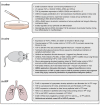EGFR Signaling in Lung Fibrosis
- PMID: 35326439
- PMCID: PMC8947373
- DOI: 10.3390/cells11060986
EGFR Signaling in Lung Fibrosis
Abstract
In this review article, we will first provide a brief overview of the ErbB receptor-ligand system and its importance in developmental and physiological processes. We will then review the literature regarding the role of ErbB receptors and their ligands in the maladaptive remodeling of lung tissue, with special emphasis on idiopathic pulmonary fibrosis (IPF). Here we will focus on the pathways and cellular processes contributing to epithelial-mesenchymal miscommunication seen in this pathology. We will also provide an overview of the in vivo studies addressing the efficacy of different ErbB signaling inhibitors in experimental models of lung injury and highlight how such studies may contribute to our understanding of ErbB biology in the lung. Finally, we will discuss what we learned from clinical applications of the ErbB1 signaling inhibitors in cancer in order to advance clinical trials in IPF.
Keywords: ErbB-signaling; TGF-α; TGF-β; amphiregulin; epidermal growth factor; epidermal growth factor receptor; idiopathic pulmonary fibrosis; lung fibrosis; neuregulin 1; pulmonary fibrosis; tyrosine kinase inhibitor.
Conflict of interest statement
The authors declare no conflict of interest.
Figures


References
-
- Ullrich A., Coussens L., Hayflick J.S., Dull T.J., Gray A., Tam A.W., Lee J., Yarden Y., Libermann T.A., Schlessinger J. Human epidermal growth factor receptor cDNA sequence and aberrant expression of the amplified gene in A431 epidermoid carcinoma cells. Nature. 1984;309:418–425. doi: 10.1038/309418a0. - DOI - PubMed
-
- Kraus M.H., Issing W., Miki T., Popescu N.C., Aaronson S.A. Isolation and characterization of ERBB3, a third member of the ERBB/epidermal growth factor receptor family: Evidence for overexpression in a subset of human mammary tumors. Proc. Natl. Acad. Sci. USA. 1989;86:9193–9197. doi: 10.1073/pnas.86.23.9193. - DOI - PMC - PubMed
-
- Plowman G.D., Culouscou J.M., Whitney G.S., Green J.M., Carlton G.W., Foy L., Neubauer M.G., Shoyab M. Ligand-specific activation of HER4/p180erbB4, a fourth member of the epidermal growth factor receptor family. Proc. Natl. Acad. Sci. USA. 1993;90:1746–1750. doi: 10.1073/pnas.90.5.1746. - DOI - PMC - PubMed
Publication types
MeSH terms
Substances
Grants and funding
LinkOut - more resources
Full Text Sources
Research Materials
Miscellaneous

